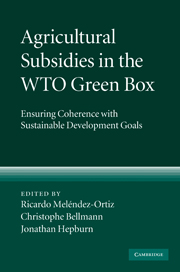Book contents
- Frontmatter
- Contents
- List of contributors
- Preface
- Acknowledgements
- List of abbreviations
- 1 Overview
- PART I The recent evolution of agricultural trade policy reform
- 2 The historical context of the green box
- 3 Doha Round negotiations on the green box and beyond
- 4 The reform of the EU's Common Agricultural Policy
- 5 Farm policy reform in the United States: past progress and future direction
- 6 Agricultural trade policy reform in Japan
- PART II The focus, extent and economic impact of green box subsidies
- PART III Green box subsidies and developing countries
- PART IV Green box subsidies and the environment
- PART V Looking forward: how can change take place?
- Appendix: Text of Annex 2 of the WTO Agreement on Agriculture (“the green box”)
- Index
- References
2 - The historical context of the green box
from PART I - The recent evolution of agricultural trade policy reform
Published online by Cambridge University Press: 03 May 2010
- Frontmatter
- Contents
- List of contributors
- Preface
- Acknowledgements
- List of abbreviations
- 1 Overview
- PART I The recent evolution of agricultural trade policy reform
- 2 The historical context of the green box
- 3 Doha Round negotiations on the green box and beyond
- 4 The reform of the EU's Common Agricultural Policy
- 5 Farm policy reform in the United States: past progress and future direction
- 6 Agricultural trade policy reform in Japan
- PART II The focus, extent and economic impact of green box subsidies
- PART III Green box subsidies and developing countries
- PART IV Green box subsidies and the environment
- PART V Looking forward: how can change take place?
- Appendix: Text of Annex 2 of the WTO Agreement on Agriculture (“the green box”)
- Index
- References
Summary
Some history
The International Economy
The long-term growth and composition of international trade depends, at the economic level, upon changes in demand and, ultimately, production patterns, and at the political level, on the interaction of conflicts of interest and cooperative efforts among different national states and regions. The General Agreement on Tariffs and Trade (GATT), from its inception after the Second World War, and the World Trade Organization (WTO), from 1994 onwards, are clear examples of the struggle to reign over these conflicts of interest and, at the same time, to adapt multilateral institutions to the changing patterns of the international economy. Agriculture by itself is an ideal field of research to test these changes in demand and the political interaction already referred to.
From an economic point of view, for more than 60 years after the crisis of 1929, farming production was affected by decreasing income elasticity of demand, meaning that its share in total consumption diminished at the same time as income grew. This process, which can be called the autonomous trend of demand, led to changes in world relative prices (terms of trade) between agriculture and manufactured goods.
The adjustment in supply that should have followed as a result of this change was nevertheless not automatic, depending on the commercial policies followed at the national level.
- Type
- Chapter
- Information
- Agricultural Subsidies in the WTO Green BoxEnsuring Coherence with Sustainable Development Goals, pp. 19 - 35Publisher: Cambridge University PressPrint publication year: 2009



